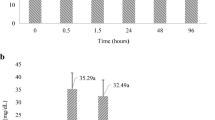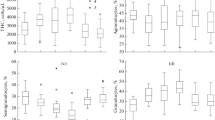Abstract
The Norwegian lobsterNephrops norvegicus (L.) collected from Firth of Clyde, Scotland between December 1987 and March 1988, was unable to survive longer than 18 h experimental emersion at 10°C. During this time the partial pressure of oxygen (P ν O2) in the venous blood decreased rapidly and the lobster supplemented cellular energy requirements by anaerobic metabolism. This was indicated by the rapid accumulation ofL-lactate in the blood. Although the survival rate increased (to ca 36 to 48 h) if lobsters were kept on ice, the accumulation ofL-lactate in the blood was not significantly different from lobsters at 10°C, despite the temperature difference. There was no indication thatN. norvegicus was able to further metabolize circulatingL-lactate during emersion. On emersion there was also a marked hyperglycemia in the blood due to the stress of handling and asphyxiation. There was fairly good agreement between results obtained during laboratory studies and simulated fishing activity in the Firth of Clyde. Both sets of results are discussed in the context of adaptation to air breathing within the Crustacea and an assesment of post-harvest treatment of lobsters.
Similar content being viewed by others
Literature cited
Albert, J. L., Ellington, W. R. (1985). Patterns on energy metabolism in the stone crabMenippe mercenaria, during severe hypoxia and subsequent recovery. J. exp. Zool. 234: 175–183
Allen, J. A. (1967). The fauna of the Clyde Sea area. Crustacea: Euphausiacea and Decapoda. Scottish Marine Biological Association, Millport
Bailey, N., Howard, F. G., Chapman, C. J. (1986). ClydeNephrops: biology and fisheries. Proc. R. Soc. Edin. (Sect. B) 90: 501–518
Bridges, C. R., Brand, A. R. (1980). The effect of hypoxia on oxygen consumption and blood lactate levels of some marine Crustacea. Comp. Biochem. Physiol. 65A: 399–409
Burnett, L. E. (1988) Physiological responses to air exposure: Acid base balance and the role of branchial water stores. Am. Zool. 28: 125–135
DeFur, P. L. (1988) Systemic respiratory adaptations to air exposure in intertidal decapod crustaceans. Am. Zool. 28: 115–124
DeFur, P. L., McMahon, B. R. (1984). Physiological compensation to short-term air exposure in red rock crabsCancer productus Randall, from littoral and sublittoral habitats. I. Oxygen uptake and transport. Physiol. Zoöl. 57: 137–150
DeFur, P. L., Pease, A., Siebelink, A., Elfers, F. (1988). Respiratory responses of the blue crabs,Callinectes sapidus to emersion. Comp. Biochem. Physiol. 89A: 97–101
Engel, P. C., Jones, J. B. (1978). Causes and elimination of erratic blanks in enzymatic metabolite assays involving the use of NAD+ in alkaline hydrazine buffers: improved conditions for the assay of L-glutamine, L-lactate and other metabolites. Analyt. Biochem. 88: 475–484
Gäde, G. (1984). Effects of oxygen deprivation during anoxia and muscular work on the energy metabolism of the crayfish,Orconectes limosus. Comp. Biochem. Physiol. 77A: 495–502
Gutmann, I. A., Wahlefeld, W. (1974). L-(+)-lactate determination with lactate dehydrogenase and NAD. In: Bergmeyer, H. U. (ed.) Methods of enzymatic analysis, 2nd edn. Academic Press, New York, p. 1464–1468
Hill, A. D., Taylor, A. C., Strang, R. H. C. (1989). Anaerobic metabolism in the crab,Carcinus maenas. Abstracts. Soc. Exp. Biol. Edinburgh, 3 to 7th April, 1989, p. A15, article 3
Hummel, H., Fortuin, A. W., DeWolf, L., Meijboom, A. (1988). Mortality of intertidal benthic animals after a period of prolonged exposure. J. exp. mar. Biol. Ecol. 121: 247–254
Johnson, I., Uglow, R. F. (1985). Some effects of aerial exposure on the respiratory physiology and blood chemistry ofCarcinus maenas (L.) andLiocarcinus puber (L.). J. exp. mar. Biol. Ecol. 94: 151–165
Kleinhotz, L. H. (1948). Experimental hyperglycaemia in the marine crustacean,Libinia emarginata. Anat. Rec. 101: 734
Newlands, P. L., Chapman, C. J., Neil, D. M. (1988). Swimming performance and endurance of the Norway lobsterNephrops norvegicus. Mar Biol. 98: 345–350
Phillips, J. W., McKinney, R. J. W., Hird, F. J. R., MacMillan, D. L. (1977) Lactic acid formation in crustaceans and the liver function of the mid gut questioned. Comp. Biochem. Physiol. 56B: 427–433
Roe, J. H., (1955). The determination of sugar in blood and spinal fluid with anthrone reagent. J. biol. Chem. 212: 335–353
Slein, M. W. (1965). D-glucose. Determination with hexokinase and glucose-6-phosphate dehydrogenase. In: Bergmeyer, H. U. (ed.) Methods of enzymatic analysis. Academic Press, New York, p. 117–123
Taylor, A. C., Spicer, J. I. (1988). Functional significance of a partial emersion response in the intertidal prawnPalaemon elegans (Crustacea: Palaemonidae) during environmental hypoxia. Mar. Ecol. Prog. Ser. 44: 141–147
Taylor, E. W., Butler, P. J. (1978). Aquatic and aerial respiration in the shore crab,Carcinus maenas (L.), acclimated at 15°C. J. comp. Physiol. (Sect. B) 127: 315–323
Taylor, E. W., Wheatly, M. G. (1981). The effect of long term aerial exposure on heart rate, ventilation, respiratory gas exchange and acid-base status in the crayfish,Austropotamobius pallipes. J. exp. Biol. 92: 109–124
Teal, J. M., Carey, F. G. (1967). The metabolism of marsh crabs under conditions of reduced oxygen pressure. Physiol. Zoöl. 40: 83–91
Telford, M. (1968). The effects of stress on blood sugar composition of the lobster,Homarus americanus. Can. J. Zool. 46: 819–826
Telford, M. (1973). Blood glucose in crayfish — II Variation induced by artificial stress. Comp. Biochem. Physiol. 48 A: 555–560
Thomas, H. J. (1954). The oxygen uptake of the lobster (Homarus vulgaris). J. exp. Biol. 31: 228–251
Author information
Authors and Affiliations
Additional information
Communicated by R. O'Dor, Halifax
Rights and permissions
About this article
Cite this article
Spicer, J.I., Hill, A.D., Taylor, A.C. et al. Effect of aerial exposure on concentrations of selected metabolites in blood of the Norwegian lobsterNephrops norvegicus (Crustacea: Nephropidae). Mar. Biol. 105, 129–135 (1990). https://doi.org/10.1007/BF01344278
Accepted:
Issue Date:
DOI: https://doi.org/10.1007/BF01344278




